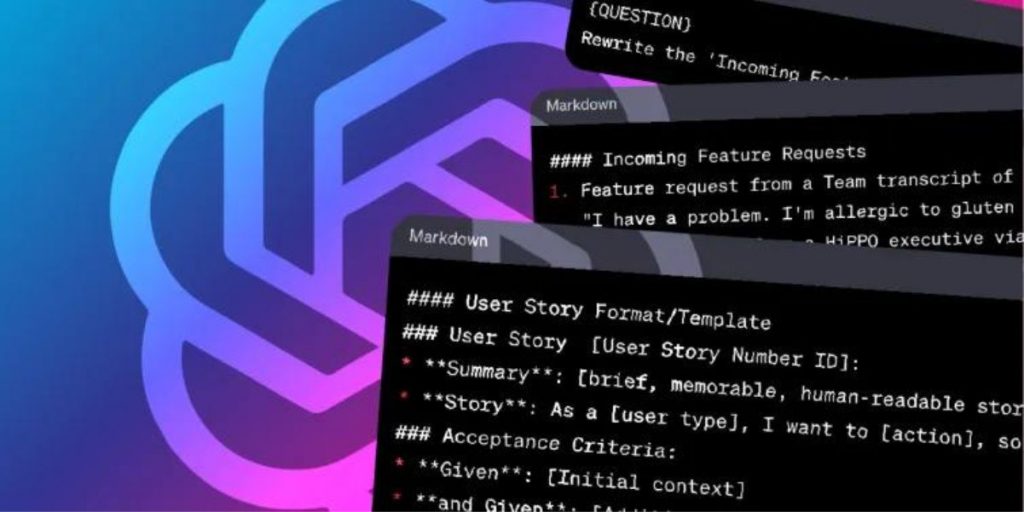
In this, the third and final part of our series on integrating ChatGPT into a product manager’s (PM) daily operations, we delve into how ChatGPT can assist with mundane yet critical tasks like formulating user stories. Here, we demonstrate how a fictional yet ‘real enough’ product manager at an Agile SaaS company utilizes ChatGPT to transform raw asynchronous requests into a polished set of user stories.
TL; DR
- With ChatGPT and user stories, Dean Peters demonstrates a repeatable structure for future dialogues.
- Overcome a flood of incoming ideas using the paid version of ChatGPT to normalize these “promises for a conversation.”
- Follow our 6 “Programing with Words” techniques to amp up your prompt engineering outcomes.
After our previous blog post, ChatGPT has continued to evolve, addressing data privacy issues, providing plugins to its paying customers, and just the other day a powerful code interpreter. Its progress in shaping valuable dialogs is noticeable, something we glimpsed in our prior articles here: Using ChatGPT as a Product Management Tool and Using ChatGPT to Perform Competitive Analysis.
In today’s installment, we shift our focus from strategic to tactical concerns, demonstrating how you can leverage ChatGPT to eliminate the tedium of everyday formatting and documentation, freeing up more time for valuable conversations. We’re turning the spotlight onto user stories.
As outlined in our Agile Product Management (APM) and Digital Product Management courses, user stories serve as a potent yet straightforward tool that PMs can use as a shared language for discussing feature requests and product ideas that benefit your organization in the following ways:
- Close the communication gap, ensuring shared understanding.
- Foster collaboration with simplicity and flexibility.
- Encourage swift response to changes, promoting adaptability.
- Provide a foundation for Agile development’s estimation and planning.
- Promote a user-centric approach in the development effort.
This isn’t news to most of you, so let’s make this fun, take a flight of fancy, and imagine you’re a newly hired Product Manager at an Agile SaaS company. You want to leverage the benefit of user stories. Still, you’re inundated with emails from Outlook and suggestions from Slack, feeling overwhelmed and with no time to frame and format these incoming suggestions.
Not much fun, I know, but to the rescue, we incorporate “programming with words” method to help us reshape the requests from diverse channels and output them using a blend of Mike Cohn’s User Story Format and Gherkin-style Acceptance Criteria. Using these six prompt engineering tactics, we see how we can use the paid version of ChatGPT to help scaffold any strategic or tactical conversation centerpiece.
Heads up: Don’t stress about the quality of the prompts we’re drafting to solicit responses from ChatGPT. Consider this as a navigational tool on how to maximize this tool’s utility in your professional life.
Tactic 1 – Set the Stage in the [CONTEXT] Block
Just as setting the stage for a product demo or a user story creates a shared understanding among your team, setting up the [CONTEXT] block forms a clear vision for the AI model. Think of it as defining your product vision or scope.
[CONTEXT]
## Converting Feature Requests into User Stories with ChatGPT
## Incoming Feature Requests
Tactic 2 – Few-Shot Prompt with Examples
Similar to how user stories are better understood with real-world use cases, providing multiple examples to the AI model can improve its understanding and adaptability. Each example or ‘shot’ helps the model learn more about the task at hand.
1. Feature request 1 …
_”I’m allergic to gluten, and I love pizza…
2. Feature request 2 …
_”Our app needs a feature that instantly notifies users about their pizza delivery progress…
Tactic 3 – Organize Context Hierarchically
Just as you would organize user stories within a feature or features within an epic, using Markdown to add a hierarchical structure to your prompts help the AI understand and prioritize the key pieces of information. This clarity improves the relevance and quality of its responses.
## User Story Format/Template
### User Story [User Story Number ID]:
* **Summary**: [concise, memorable, human-readable story title]
* **Story**:
**As a** [user type],
**I want to** [action],
**so that** [outcome]
Tactic 4 – Specify Output Format with Form Brackets
Just as you would set the Definition of Done for a user story, using form brackets shapes the AI’s output according to your specific requirements. These brackets act as placeholders for the information the model should provide, ensuring the output aligns with your expectations. Markdown makes it look good.
### User Story [User Story Number ID]:
* **Summary**: [concise, memorable, human-readable story title]
* **Story**:
**As a** [user type],
**I want to** [action],
**so that** [outcome]
### Acceptance Criteria:
* **Scenario**: [concise, human-readable user scenario]
* **Given**: [Initial context]
* **and Given**: [Additional Given context]
* **and Given** [additional Given context statements as needed]
* **When**: [Event occurs]
* **Then**: [Expected outcome]
Tactic 5 – Contextual Embedding for Tone, Voice, and Audience
Just as you tailor your communication style when addressing different stakeholders, aligning the tone, voice, and style of your prompts to your organizational culture ensures the model’s responses resonate with your team and stakeholders. This tactic ensures the AI output reflects your company’s unique language and style.
1. Feature request from a Solution-Seeking Seagull Manager on Slack …
2. Feature request from an Output-Obsessed HiPPO executive via Outlook …
…
The following format combines the Mike Cohn User Story Format augmented by a Gherkin-style acceptance criterion …
Tactic 6 – Direct Instruction with the [QUESTION] Block
Similar to defining clear acceptance criteria for a story or setting a precise goal for each sprint, using the [QUESTION] block helps keep the AI focused on your main task. This technique ensures the AI produces responses that align with your project objectives.
[QUESTION]
Please rewrite the ‘Incoming Feature Requests’ using the ‘User Story Format.’
Conclusion
By engineering prompts beyond the conventional 0-shot or 1-shot examples widely showcased on social media, we unlock ChatGPT’s ability to empower Product Managers by streamlining user stories creation from raw feature requests. Acting as a scribe, it takes on the burdensome task of formatting and documenting, enabling you to prioritize value-centric discussions. Whether your challenge is converting diverse requests into a unified format or maintaining a consistent tone and style across all communications, ChatGPT is a valuable assistant for the modern Agile PM.
You can try this out for yourself via a ChatGPT3 version of ‘Formatting Feature Requests as User Stories using ChatGPT’ we’ve provided online.
DISCLAIMER: ChatGPT isn’t a replacement for product discovery or product delivery. Rather, it supplements and accelerates these activities. It is an impressive tool, assisting PMs in framing problems, conducting preliminary research, shaping ideas, fostering engaging conversations, and sparking creativity.



